(Written by William)
For the past few years, I’ve been dipping my toes into what LEGO Technic has to offer. All the big LEGO Creator Fairground sets that I like so much have a heavy dose of gears, axles, and other working parts that really showcase what a well-engineered LEGO set is capable of. Combining this with my appreciation of the LEGO Creator Expert vehicles with their own advanced framing and play features, I knew I needed to check out a moderately sized LEGO Technic set.
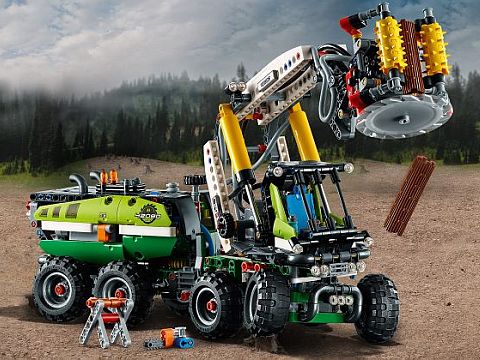
When I first heard about the #42080 LEGO Technic Forest Machine back in 2018, I must admit I was intrigued. Along with its more unconventional design, the feature that really perked my interest was the fact that it had pneumatics. I had missed out on any previous set featuring air power, so I figured this would be sort of the deeper end of LEGO Technic. The price, on the other hand, made me keep my distance. But when the holidays rolled around, I tracked down a sale on the set and asked my wife to pick it up for me for Christmas.
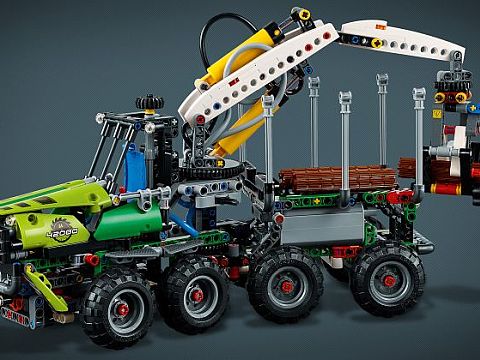
Although building the LEGO Technic Forest Machine was not beyond my skill level, I must admit it was exhausting. Just imagine those moments when you’re building something and have no idea what it is until you’re near the end. It’s interesting, but could also be frustrating. Well, that frustration happened through most of the build for me. So much was foreign that I needed to take more breaks than normal before I finished. This by no means indicate that I think it’s a bad set. In fact, I feel prouder than normal that it all came together and works. I just want to point out that LEGO Technic sets take longer to build, and that your enjoyment will depend on how much you like or dislike suspension and surprises. But enough of the feels. The real question is, what can this set teach us?
WORKING WITH LEGO TECHNIC PNEUMATICS
The box of the #42080 LEGO Technic Forest Machine touted this set as using the 2.0 version of the LEGO Technic pneumatics system. Unfortunately, I can’t compare the old version to this as I never owned any of those sets, but suffice it to say, it’s not exactly what I imagined. For starters, you still use a basic rotary motor to power the pneumatics. This is connected to a fairly simple pump. It’s sort of like a pump you’d use to inflate a ball or bicycle tire, and it provides a constant positive air pressure that everything else works off of.

Another thing I didn’t expect is that the whole system must not be air tight. If it were, the air pressure would get so great, it would start blowing parts of the model all over the place. Additionally, it helps to have a bit of air pressure built up before the functions respond reliably. After starting, the pump delivers air to two valves at the front sides of the machine. These valves do not really move if they have no air pressure to work with. Each valve has three connections for hoses. One is used as an intake, which is the center connection. The other two are meant to form a closed circuit. This is where things can get a little fuzzy.
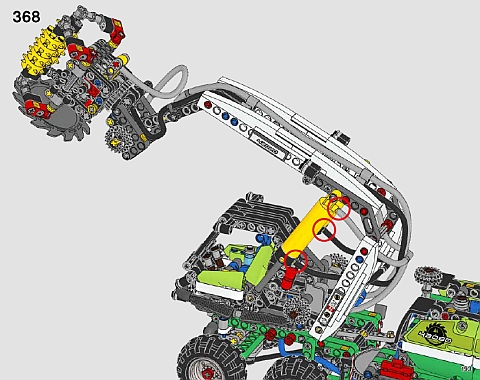
You see, all this air pressure still needs to be used. So far, we are only producing it and directing it. That’s where the additional pump/pistons come into play. Just like the initial pump that creates the air pressure, each pump/piston has two connection points for hoses. Depending on which way air blows into these, will determine whether the part expands or contracts. So if you connect hoses to each side of a valve, you can instruct the pump/piston in which direction it needs to go. However, figuring all this out amidst the various parts of the machine can be a bit tough to see. Especially when you’re trying to connect a hose in an awkward spot. Connecting hoses is the least fun thing about a pneumatic system. Hopefully though, this gives you a basic primer as to what you’re getting yourself into if you pursue pneumatics.
SIDE-TO-SIDE & INNER-OUT BUILDING WITH LEGO
Through the entire building process of the #42080 LEGO Technic Forest Machine, I kept wondering; why does all of this feel so foreign to me? Apart from the pneumatics parts and some specially shaped panels, I was familiar with most of the things I was working with. Yet the feeling that I was out of my element persisted. After a lot of thought, I came to the conclusion that this feeling has to do with the basic approach that LEGO Technic sets use in their design.
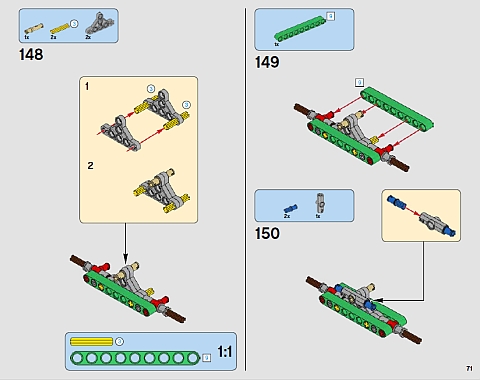
In a normal LEGO systems set, we often build bottom to top. Sure, there are some sideways building moments, but we simply need a foundation to work off of, and building bottom to top fulfills this need. In a LEGO Technic set, functionality is the primary goal. This means setting up the mechanisms to work right becomes the foundational building point. For this reason, it’s easier to figure out mechanisms by starting out from one side and then adding the other side on later. Much of what I worked on in this set made no sense to me since I was often constructing one side of the model, then balancing it out by assembling its other side.
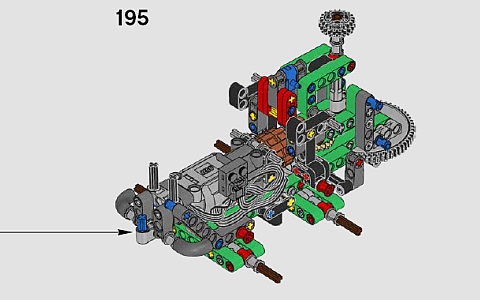
To complicate matters, I was instructed to do this multiple times, so I’d not only be building side to side but from the inside out. This is a very odd way to conceptualize a design for those of us that mostly built with the standard LEGO system. And if all that wasn’t weird enough already, LEGO Technic also seems to prefer to use odd numbers in how things are built. In other words, you make a lot of things that are three or five beam widths wide. This, of course, allows gears to be centered, but it messes with your head when you’re used to making things four, six, or eight studs wide.
APPLYING WHAT YOU LEARN
It turns out that pneumatics is a mixed bag for me. On one hand, the effect that it produces looks amazing. There’s nothing quite like hearing the hiss of air and seeing things work. The problem for building something like this myself is all the special pieces needed. You may also find you have to buy longer hoses than you really need so that you can cut them down to their proper lengths. Honestly, pneumatics might be fun in an official set, but I’d leave it to the seasoned LEGO Technic builders to attempt building custom models.
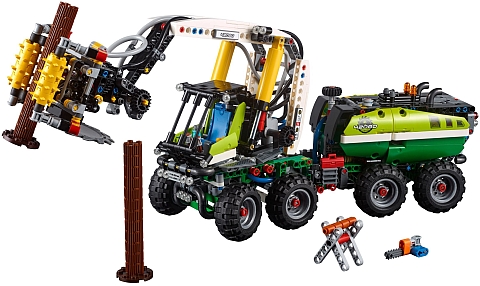
As for changing your building perspective to fit the priorities of the LEGO Technic design, my suggestion is to prototype a mechanism first. Create whatever scaffolding you need to accommodate the elements you want to function. Chances are, this is exactly what you’ll need for the finished product anyways. Everything else is just securing the mechanism in place and making sure you’re not blocking any important moving parts.
I do want to point out, there are a ton of other techniques I didn’t mention in this article. The truth is, I want to expose myself to a bit more LEGO Technic building style sets before I feel comfortable discussing these features. I can’t be certain if they were just an anomaly in this set, or if they’re standard practice. But I’m pretty sure this won’t be the last LEGO Technic set I try out! In the vide below, I will share a few more thoughts about the set.
What do you think? Do you have any LEGO Technic sets with pneumatic functions? How do you like them? And what do you think about building with LEGO Technic in general? Feel free to share your thoughts and discuss in the comment section below!
And you might also like to check out the following related posts:












I forgot to mention that in certain regions this set might be called Forest Harvester instead of Forest Machine.
Personally I would have prefered calling it Harvester, but in the U.S. it’s Forest Machine.
Americans always want their machines to be big and menacing. Ha-ha! 😀
I kinda like how the term “harvester” sounds more specific.
Also, “International Harvester” was the name of a classic Swedish progressive rock band from the 1960s…
https://www.youtube.com/watch?v=yCiHo51yw1I
Wow. I didn’t know Technic sets have pneumatics! This is a gamechanger! Are there any current sets with this feature?
Apart from this set, I do believe the giant Liebherr R 9800 Excavator might also have pneumatics.
At least I saw pneumatic tubing on it when someone brought it in to our last LUG meeting.
Those are the only ones I know off the top of my head that are currently available.
Looks like the next most recent set with a pneumatic play feature was 42053 Volvo EW160E . It is retired, but it’s not a terrible price on the secondary market.
Only issue is the pneumatics are manual so you have to pump it by hand.
The first Technic pneumatic set appeared somewhere in the 80’s, I believe, although they have always been a niche.
https://lego.fandom.com/wiki/Pneumatic
(The Brickset system seems to be broken, so you can’t search for tags, or perhaps I just need to update my browser…)
I remember looking at this set, but I didn’t realize it had such advanced functions. I should have looked at a video review or something.
I don’t blame you. It wasn’t until I saw this set on sale that I really gave it a fair shake.
When I first heard about it I thought, that name sounds cool. Then I saw the price and thought, not that cool.
Now I’m glad I got one!
I would love to play around with this set. It’s not the prettiest, but the functions are worth it imho.
Agreed,
There were times even near the end of the build I was still scratching my head as to what this part or that part was meant to be.
It’s totally a work horse type machine, and not in line to win any beauty contests.
I have this set. It’s fantastic. Like others said, it’s not the prettiest, but this is a forest machine after all, not some supercar. I agree with Will that it’s hard to wrap your brain around what you’re building. Newer Technic sets are better with this with showing blueprints of the sections you build.
That would make a world of difference. Having a blueprint outlining how the functions all work on a practical level would really raise this up a notch or two.
Speaking of interesting functions. There is a third party that sells hydrolics that you can use to modify this set. So instead of a system with air it all runs on water. That might be a bit easier to follow since you can actually see where the water goes.
I was always intimidated by technic. What is a good set to try? Reading this review made me want to try.
Medium-ish sets around the $50 range are pretty good starter sets with enough functions to be interesting. 🙂
The key is that you want to get beyond the most basic function that you’ll probably see in a System set and need to experience something that chains several things together.
As Admin points out, you start seeing that around the $50 mark.
You can also try looking at JKBrickworks and some of the instructions he makes. His stuff does use System, but so much of it is grounded in the practical applications of complex Technic designs. And he does have some small MOCs you can try out.
What has happened with the comment system? It seems the “reply tree” function is broken…
Hakan, don’t worry, it’s not broken. I’m slowly making some changes as we get transitioned over to the new Theme. Some of the changes are more visible than others. I figured doing it little by little is better than all at once and shocking everyone. 😀
We do have to update, as there is no way to make the current theme responsive, which is now pretty much a requirement for all sites. Non-threaded comments work better on mobile, so thus the change.
Brickset also has non-threaded comments and it seem to work well. For us, it’s a bit of adjustment, as we are so used to it. If you guys really hate it, I can make threaded comments go maybe 1-3 levels deep. The issue with only having 1-3 level deep comments is that people get confused when some comment replies show up as threaded and others as non-threaded. So I figured it’s best to just do away with it and turn off threaded comments altogether. Let me know your thoughts. 🙂
@admin
Well, I guess I could always start replying in the @poster function, it seems to be a well established format, anyway.
You can also use the blockquote tags, like I’m doing here. I’m also looking at options to add a quote button to comments. That would allow you to quote comments without threading.
@admin
How do you write/ use blockquote tags?
A quote button could indeed be useful.
You copy and paste the section you want to quote into the comment box, then add blockquote at the beginning of the section you want to quote and /blockquote at the end. With the little triangle thingies surrounding both tags. This works on all WP sites. 🙂
P.S. I’m working on the quote button thing.
Thanks. Trying it out.
I have to agree with your very first point about the fairground sets. I’m just emerging from my dark ages (about six months ago). The fairground sets would have been called Technic when I was a kid. I remember playing with Technic sets that were mostly System bricks but with axles, gears, and such for transmissions, engines, and moving seats in cars. (Think early 80s.) What we call Technic pieces today didn’t exist back then, even though the line did exist.
I built the roller coaster and carousel before I looked at my first true Technic set, and even after seeing the completed product I was a bit surprised at how few System bricks were involved. The evolution is impressive, if a little jarring after ignoring it for 30+ years. It wasn’t until I finished the Top Gear car that I realized my definition of Technic pieces as “bricks with holes in them” was rather dated.
I notice I don’t love the look of Technic models when completed. I would LOVE to see more things like the fairground sets, incorporating mostly System bricks for everything aesthetic, and using the Technics mechanics to make things work. With that said, I’m still fascinated by how it all comes together, and I love more complex mechanics. I’ll keep building Technic from time to time, but I do wish they looked more System.
Thanks for all you do!